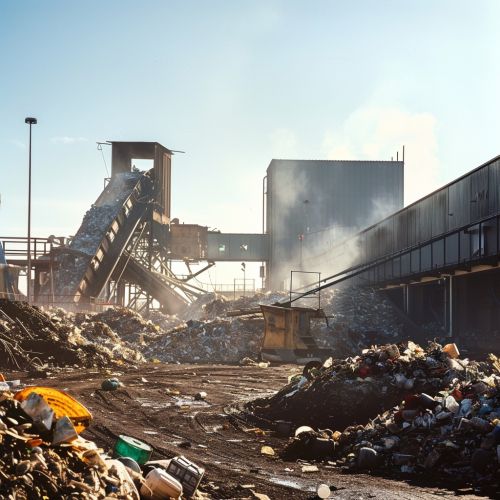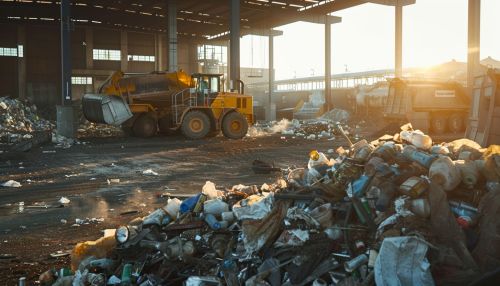Industrial waste
Introduction
Industrial waste refers to the byproducts generated from industrial activities, including manufacturing, processing, and extraction processes. These wastes can be in solid, liquid, or gaseous forms and often contain hazardous substances that pose significant risks to human health and the environment. The management and disposal of industrial waste are critical issues that require stringent regulatory frameworks and advanced technological solutions.
Types of Industrial Waste
Industrial waste can be broadly categorized into several types based on its origin, composition, and potential hazards.
Solid Waste
Solid industrial waste includes a variety of materials such as metals, plastics, glass, and organic matter. Common sources include manufacturing plants, construction sites, and mining operations. Solid waste can be further classified into:
- **Municipal Solid Waste (MSW)**: Waste generated from industrial activities that resemble household waste.
- **Hazardous Waste**: Waste that poses substantial or potential threats to public health or the environment, often containing toxic, corrosive, flammable, or reactive substances.
Liquid Waste
Liquid industrial waste primarily consists of wastewater and process effluents. These wastes often contain high levels of pollutants, including heavy metals, organic compounds, and chemicals. Key sources include:
- **Chemical Manufacturing**: Produces waste containing various hazardous chemicals.
- **Food Processing**: Generates organic-rich effluents that can lead to eutrophication if not properly treated.
Gaseous Waste
Gaseous industrial waste includes emissions from industrial processes and combustion activities. These emissions can contain pollutants such as sulfur dioxide (SO₂), nitrogen oxides (NOₓ), carbon monoxide (CO), and volatile organic compounds (VOCs). Major sources include:
- **Power Plants**: Emit large quantities of greenhouse gases and other pollutants.
- **Manufacturing Facilities**: Release various toxic gases during production processes.


Sources of Industrial Waste
Industrial waste originates from a wide range of industrial activities. Key sources include:
Manufacturing Industries
Manufacturing processes generate significant amounts of waste, including scrap materials, defective products, and process residues. Industries such as automotive, electronics, and textiles are major contributors.
Mining and Mineral Processing
Mining operations produce large volumes of waste rock, tailings, and slag. These wastes often contain hazardous substances such as heavy metals and radioactive materials.
Chemical and Pharmaceutical Industries
These industries generate waste containing a variety of hazardous chemicals, including solvents, acids, and byproducts from chemical reactions.
Food and Beverage Industry
The food and beverage industry produces organic waste, including food scraps, wastewater, and packaging materials.
Environmental Impact
The improper management and disposal of industrial waste can have severe environmental consequences. Key impacts include:
Soil Contamination
Industrial waste can lead to soil contamination, affecting soil fertility and posing risks to plant and animal life. Contaminants such as heavy metals and persistent organic pollutants (POPs) can persist in the soil for extended periods.
Water Pollution
Wastewater and effluents from industrial activities can contaminate water bodies, leading to the degradation of aquatic ecosystems. Pollutants such as heavy metals, nutrients, and organic compounds can cause eutrophication, harming aquatic life and reducing water quality.
Air Pollution
Emissions from industrial processes contribute to air pollution, affecting air quality and human health. Pollutants such as sulfur dioxide, nitrogen oxides, and particulate matter can cause respiratory problems and other health issues.
Health Impacts
Exposure to industrial waste can have significant health implications for workers and nearby communities. Key health risks include:
Toxicity
Many industrial wastes contain toxic substances that can cause acute or chronic health effects. Exposure to heavy metals, such as lead and mercury, can lead to neurological and developmental disorders.
Respiratory Issues
Airborne pollutants from industrial activities can cause respiratory problems, including asthma, bronchitis, and lung cancer. Long-term exposure to particulate matter and toxic gases can exacerbate these conditions.
Carcinogenic Effects
Certain industrial chemicals are known carcinogens, increasing the risk of cancer among exposed individuals. For example, prolonged exposure to asbestos fibers can lead to mesothelioma and lung cancer.
Waste Management Strategies
Effective industrial waste management involves a combination of regulatory measures, technological solutions, and best practices. Key strategies include:
Source Reduction
Source reduction involves minimizing waste generation at the source through process optimization, material substitution, and efficient resource use. This approach reduces the volume and toxicity of waste produced.
Recycling and Reuse
Recycling and reuse of industrial waste materials can conserve resources and reduce environmental impact. For example, scrap metals can be recycled into new products, and wastewater can be treated and reused in industrial processes.
Treatment and Disposal
Proper treatment and disposal of industrial waste are essential to mitigate environmental and health risks. Treatment methods include physical, chemical, and biological processes to remove or neutralize contaminants. Disposal options include landfilling, incineration, and deep-well injection.
Regulatory Framework
The management of industrial waste is governed by various international, national, and local regulations. Key regulatory frameworks include:
International Conventions
International conventions, such as the Basel Convention, regulate the transboundary movement and disposal of hazardous waste. These agreements aim to protect human health and the environment from the adverse effects of hazardous waste.
National Regulations
Countries have established national regulations to manage industrial waste, including the Resource Conservation and Recovery Act (RCRA) in the United States and the Waste Framework Directive in the European Union. These regulations set standards for waste generation, treatment, and disposal.
Local Ordinances
Local governments may implement ordinances and bylaws to address specific waste management issues within their jurisdictions. These regulations often complement national and international frameworks.
Technological Innovations
Advancements in technology have led to the development of innovative solutions for industrial waste management. Key innovations include:
Waste-to-Energy (WtE)
Waste-to-energy technologies convert industrial waste into energy, such as electricity and heat. These technologies include incineration, gasification, and anaerobic digestion, providing a sustainable alternative to traditional disposal methods.
Advanced Treatment Technologies
Advanced treatment technologies, such as membrane filtration, advanced oxidation processes (AOPs), and bioremediation, offer effective solutions for treating complex industrial waste streams. These technologies can remove or degrade contaminants to meet stringent regulatory standards.
Circular Economy
The circular economy model promotes the sustainable use of resources by closing the loop on material flows. This approach encourages the design of products and processes that minimize waste generation and facilitate recycling and reuse.
Case Studies
Several case studies highlight successful industrial waste management practices and their environmental and economic benefits.
Case Study 1: Zero Waste Manufacturing
A leading electronics manufacturer implemented a zero-waste strategy, achieving a 95% reduction in waste sent to landfills. The company optimized its production processes, increased recycling rates, and collaborated with suppliers to reduce packaging waste.
Case Study 2: Industrial Symbiosis
An industrial symbiosis project in Kalundborg, Denmark, created a network of companies that exchange waste materials and energy. This collaborative approach reduced waste generation, lowered operating costs, and minimized environmental impact.
Case Study 3: Bioremediation of Contaminated Sites
A chemical manufacturing facility used bioremediation to clean up a contaminated site. The process involved the use of microorganisms to degrade hazardous chemicals in the soil and groundwater, restoring the site for safe use.
Challenges and Future Directions
Despite advancements in industrial waste management, several challenges remain. Key challenges include:
Regulatory Compliance
Ensuring compliance with complex and evolving regulations can be challenging for industries. Companies must stay informed about regulatory changes and implement necessary measures to meet compliance requirements.
Technological Limitations
While technological innovations offer promising solutions, their implementation can be limited by high costs, technical complexity, and scalability issues. Ongoing research and development are needed to overcome these limitations.
Public Awareness and Participation
Raising public awareness and encouraging participation in waste management initiatives are crucial for success. Education and outreach programs can help communities understand the importance of proper waste management and adopt sustainable practices.
Conclusion
Industrial waste management is a critical issue that requires a multifaceted approach involving regulatory frameworks, technological innovations, and best practices. Effective management can mitigate environmental and health risks, conserve resources, and promote sustainable development. Continued efforts are needed to address challenges and advance the field of industrial waste management.
